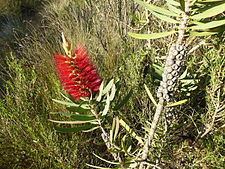Rank Species | ||
 | ||
Similar Melaleuca densa, Melaleuca phoenicea, Melaleuca leptospermoides, Melaleuca lateritia, Melaleuca dealbata | ||
Melaleuca glauca, commonly known as Albany bottlebrush is a plant in the myrtle family, Myrtaceae and is endemic to the south-west of Western Australia. (Some Australian state herbaria continue to use the name Callistemon glaucus. Craven claims that there is no type material for Callistemon speciosus and includes it here as a synonym.) It is a tall shrub with glaucous leaves and spikes of red flowers in spring.
Contents
Description
Melaleuca glauca is a shrub growing to 3.5 m (10 ft) tall with hard, fibrous bark. Its leaves are arranged alternately and are 40–128 mm (2–5 in) long, 3–18 mm (0.1–0.7 in) wide, flat, mostly narrow egg-shaped with a mid-vein and 11 to 20 branching veins.
The flowers are bright red and arranged in spikes on the ends of branches which continue to grow after flowering. The spikes are up to 75 mm (3 in) in diameter with 20 to 120 or more individual flowers. The petals are 4.5–7.2 mm (0.18–0.28 in) long and fall off as the flower ages. The stamens are arranged in five bundles around the flower and there are between 6 and 15 stamens per bundle. Flowering occurs from October to December and is followed by fruit which are woody capsules, 5.7–8.8 mm (0.2–0.3 in) long.
Taxonomy and naming
Melaleuca glauca was named in 2013 by Lyndley Craven in Melaleucas : their botany, essential oils and uses. It was first formally described in 1815 by Aimé Bonpland as Metrosideros glauca however the description was not validly published. In 1830, the English botanist Robert Sweet gave it the name Callistemon glaucus. The specific epithet (glauca) is from the Latin word glaucus meaning “blue-grey” or "blue-green" referring to the glaucous leaves.
Distribution and habitat
Melaleuca glauca occurs in the south and south-western coastal districts of Western Australia between Perth and Albany in the Jarrah Forest, Swan Coastal Plain and Warren biogeographic regions, where it grows in swampy ground in sandy or clayey soils.
Conservation
Melaleuca glauca is listed as "not threatened" by the Government of Western Australia Department of Parks and Wildlife.
Use in horticulture
Melaleuca glauca is widely grown as an ornamental (as Callistemon glaucus) in temperate parts of Australia.
